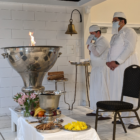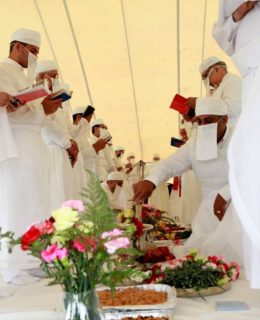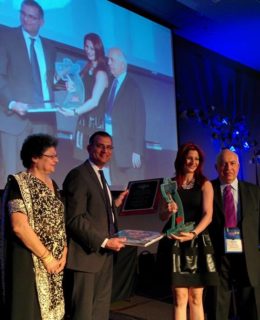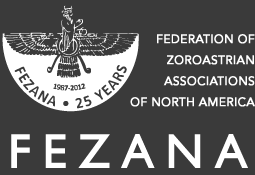FEZANA, NORTH AMERICAN MOBEDS COUNCIL ISSUE JOINT STATEMENT REITTERATING CDC GUIDANCE ON COVID-19 RISK MITIGATION FOR PLACES OF WORSHIP
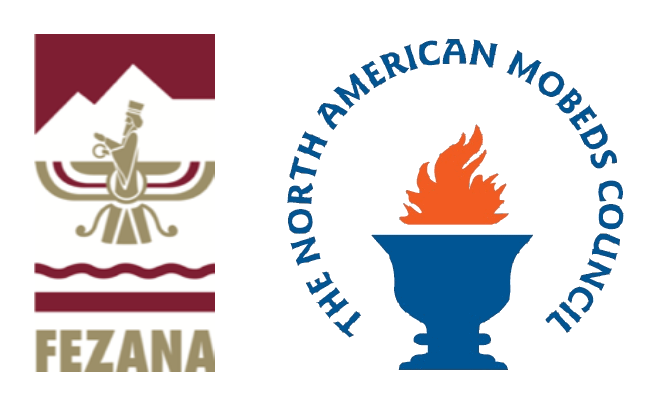
As Zarathushti associations and groups begin to open their doors or put together their plans for limited capacity in-person worship, the Federation of Zoroastrian Associations of North America (FEZANA) and the North American Mobeds Council (NAMC) have joined forces to offer and reiterate guidance from the Centers for Disease Control (CDC) on reducing risk exposure to COVID-19 to the greatest extent possible for our Mobeds/priests and congregations.
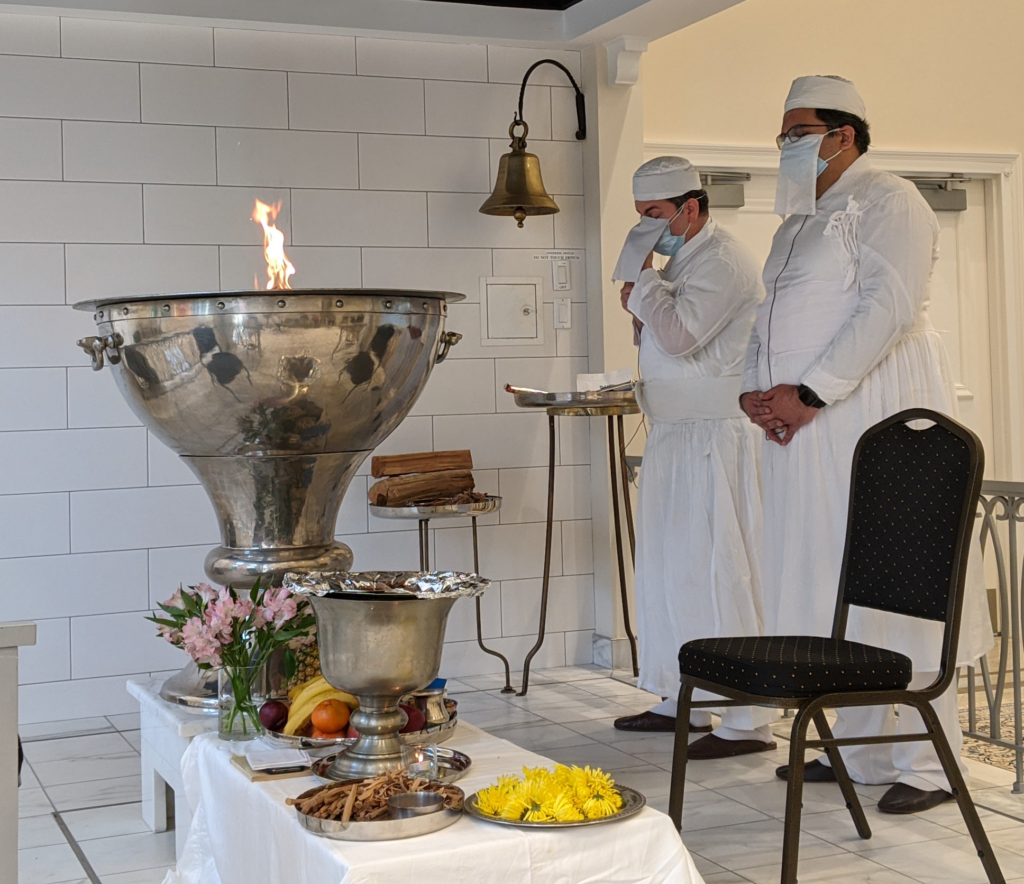
- Anyone entering a Zoroastrian place of worship should wear a mask out of respect for their fellow Zarathushtis: including Mobeds, administrators, congregants, visitors, vendors and janitorial staff.
- Socially distance 6’ to 10’ – no hugs, no hand shakes, no elbow bumps or close conversations.
- If you are elderly, have pre-existing health issues, or are sick, please use common sense and think twice about whether you want to put yourself and/or others at risk; and if prayers virtually via platforms like Zoom are perhaps a wiser option.
- If you live with the elderly (parents/grandparents), think about your actions, movements and interactions, and have a plan to address the risk of infection within the home.
- Become familiar with your local (county-by-county) numbers: positivity rate, number of new cases, hospitalizations and deaths; if you are located in a community where numbers are trending upward, use extra caution.
- USA spotlight: 55,000 new cases per day; 38 states within the United States (at the date of this publication) are surging in new Coronavirus cases as colder weather months approach.
Total U.S. cases: 8.14 million; total U.S. deaths: 220,000 as of October 18, 2020.
Source: Johns Hopkins University, The New York Times, Wikipedia
- Canada spotlight: while largely under control in Canada in proportion to percentage of population and population density, Coronavirus remains a global pandemic capable of metastasizing quickly.
Total Canada cases: 197,000; total Canada deaths: 9,751 as of October 18, 2020.
Source: Wikipedia
- Worldwide we continue to see lockdowns and other stringent measures taken, in particular within cities with dense population, as cases spike and the pandemic spreads.
_______________________________
CONSIDERATIONS FOR COMMUNITIES OF FAITH
Excerpted from the Centers for Disease Control web site @ cdc.gov – please review and circulate
https://www.cdc.gov/coronavirus/2019-ncov/community/faith-based.html
CDC offers the following general considerations to help communities of faith discern how best to practice their beliefs while keeping their staff and congregations safe. Millions of Americans embrace worship as an essential part of life. For many faith traditions, gathering together for worship is at the heart of what it means to be a community of faith. But as Americans are now aware, gatherings present a risk for increasing spread of COVID-19 during this Public Health Emergency. CDC offers these suggestions for faith communities to consider and accept, reject, or modify, consistent with their own faith traditions, in the course of preparing to reconvene for in-person gatherings while still working to prevent the spread of COVID-19.
This guidance is not intended to infringe on rights protected by the First Amendment to the U.S. Constitution or any other federal law, including the Religious Freedom Restoration Act of 1993 (RFRA). The federal government may not prescribe standards for interactions of faith communities in houses of worship, and in accordance with the First Amendment, no faith community should be asked to adopt any mitigation strategies that are more stringent than the mitigation strategies asked of similarly situated entities or activities.
In addition, we note that while many types of gatherings are important for civic and economic well-being, religious worship has particularly profound significance to communities and individuals, including as a right protected by the First Amendment. State and local authorities are reminded to take this vital right into account when establishing their own re-opening plans.
Scaling Up Operations
- Establish and maintain communication with local and State authorities to determine current mitigation levels in your community.
- Provide protections for staff and congregants at higher risk for severe illness from COVID-19. Offer options for staff at higher risk for severe illness (including older adults and people of all ages with certain underlying medical conditions) that limit their exposure risk. Offer options for congregants at higher risk of severe illness that limit their exposure risk (e.g., remote participation in services).
- Consistent with applicable federal and State laws and regulations, put in place policies that protect the privacy and confidentiality of people at higher risk for severe illness regarding underlying medical conditions.
- Encourage any organizations that share or use the facilities to also follow these considerations as applicable.
- If your community provides social services in the facility as part of its mission, consult CDC’s information for schools and businesses and workplaces, as relevant, for helpful information.
Promote healthy hygiene practices
- Encourage staff and congregants to maintain good hand hygiene, washing hands with soap and water for at least 20 seconds.
- Have adequate supplies to support healthy hygiene behaviors, including soap, hand sanitizer with at least 60 percent alcohol (for those who can safely use hand sanitizer), tissues, and no-touch trash cans.
- Encourage staff and congregants to cover coughs and sneezes with a tissue or use the inside of their elbow. Used tissues should be thrown in the trash and hands washed.
- Whenever soap and water are not readily available, hand sanitizer with at least 60% alcohol can be used.
- Consider posting signs on how to stop the spread of COVID-19 and how to promote everyday protective measures, such as washing hands, covering coughs and sneezes, and properly wearing a mask
Masks
- Encourage use of masks among staff and congregants. Masks are most essential when social distancing is difficult. Note: Masks should not be placed on children younger than 2 years old, anyone who has trouble breathing or is unconscious, and anyone who is incapacitated or otherwise unable to remove the mask without assistance. Masks are meant to protect other people in case the wearer is unknowingly infected but does not have symptoms.
Intensify cleaning, disinfection, and ventilation
- Clean and disinfect frequently touched surfaces at least daily and shared objects in between uses.
- Develop a schedule of increased, routine cleaning and disinfection.
- Avoid use of items that are not easily cleaned, sanitized, or disinfected.
- Ensure safe and correct application of disinfectants and keep them away from children.
- Cleaning products should not be used near children, and staff should ensure that there is adequate ventilation when using these products to prevent children or themselves from inhaling toxic fumes.
- Ensure that ventilation systems operate properly and increase circulation of outdoor air as much as possible by opening windows and doors, using fans, etc. Do not open windows and doors if they pose a safety risk to children using the facility.
- If your faith community offers multiple services, consider scheduling services far enough apart to allow time for cleaning and disinfecting high-touch surfaces between services. Take steps to ensure that all water systems and features (for example, drinking fountains, decorative fountains) are safe to use after a prolonged facility shutdown to minimize the risk of Legionnaires’ disease and other diseases associated with water.
Promote social distancing
- Take steps to limit the size of gatherings in accordance with the guidance and directives of state and local authorities and subject to the protections of the First Amendment and any other applicable federal law.
- Promote social distancing at services and other gatherings, ensuring that clergy, staff, choir, volunteers and attendees at the services follow social distancing, as circumstances and faith traditions allow, to lessen their risk.
- Consider holding services and gatherings in a large, well-ventilated area or outdoors, as circumstances and faith traditions allow.
- Consider appropriate mitigation measures, including taking steps to limit the size of gatherings maintaining social distancing, at other gatherings such as funerals, weddings, religious education classes, youth events, support groups and any other programming, where consistent with the faith tradition.
- Provide physical guides, such as tape on floors or walkways and signs on walls, to ensure that staff and children remain at least 6 feet apart in lines and at other times (e.g. guides for creating “one-way routes” in hallways).
Take steps to minimize community sharing of worship materials and other items
- Consistent with the community’s faith tradition, consider temporarily limiting the sharing of frequently touched objects, such as worship aids, prayer rugs, prayer books, hymnals, religious texts and other bulletins, books, or other items passed or shared among congregants, and encouraging congregants to bring their own such items, if possible, or photocopying or projecting prayers, songs, and texts using electronic means.
- Modify the methods used to receive financial contributions. Consider a stationary collection box, the main, or electronic methods of collection regular financial contributions instead of shared collection trays or baskets.
- Consider whether physical contact (e.g., shaking hands, hugging, or kissing) can be limited among members of the faith community.
- If food is offered at any event, consider pre-packaged options, and avoid buffet or family-style meals if possible.
Nursery/Childcare
- If a nursery or childcare will be provided during services and events, refer to CDC’s information on preventing the spread of COVID-19 in childcare settings and adapt as needed for your setting.
- If holding summer day camps, refer to CDC’s information on youth and summer camps and adapt as needed.
Staffing and Training
- Train all clergy and staff in the above safety actions. Consider conducting the training virtually, or, if in-person, ensure that social distancing is maintained.
Check for signs and symptoms
- Encourage staff or congregants who are sick or who have had close contact with a person with COVID-19 to stay home. Share CDC’s criteria for staying home with staff and congregants so that they know how to care for themselves and others. Consider posting signs at entrances with this information.
Plan for when a staff member or congregant becomes sick
- Identify an area to separate anyone who exhibits symptoms of COVID-19 during hours of operation, and ensure that children are not left without adult supervision.
- Establish procedures for safely transporting anyone who becomes sick at the facility to their home or a healthcare facility.
- Notify local health officials if a person diagnosed with COVID-19 has been in the facility and communicate with staff and congregants about potential exposure while maintaining confidentiality as required by the Americans with Disabilities Act (ADA) or other applicable laws and in accordance with religious practices.
- Advise those with exposure to a person diagnosed with COVID-19 to stay home and self-monitor for symptoms, and follow CDC guidance if symptoms develop.
- Close off areas used by the sick person and do not use the area until after cleaning and disinfection. Ensure safe and correct application of disinfectants and keep disinfectant products away from children.
- Advise staff and congregants with symptoms of COVID-19 or who have tested positive for COVID-19 not to return to the facility until they have met CDC’s criteria to discontinue home isolation.
Maintain healthy operations
- Implement flexible sick leave and related flexible policies and practices for staff (e.g., allow work from home, if feasible), and provide requested reasonable accommodation absent undue hardship to individuals with disabilities under the Americans with Disabilities Act (ADA) or other applicable laws and in accordance with religious practices.
- Monitor absenteeism and create a roster of trained back-up staff.
- Designate a staff person to be responsible for responding to COVID-19 concerns. Staff, clergy, volunteers, and congregants should know who this person is and how to contact them if they become sick or are around others diagnosed with COVID-19. This person should also be aware of state or local regulatory agency policies related to group gatherings.
- As volunteers often perform important duties (e.g., greeters, ushers, childcare), consider similar monitoring, planning, and training for them. Consider that volunteer and staffing may need to increase to implement cleaning and safety protocols and to accommodate additional services with reduced attendance.
- Communicate clearly with staff and congregants about actions being taken to protect their health.
Signs and Messages
- Post signs in highly visible locations (e.g., entrances, restrooms, gathering halls/community rooms/gyms) that promote everyday protective measures and describe how to stop the spread of germs (such as by properly washing hands and properly wearing a mask).
- Include messages (for example, videos) about behaviors that prevent the spread of COVID-19 when communicating with staff and congregants (such as in emails and on community websites and social media accounts).
- Find freely available CDC print and digital resources on CDC’s communications resources main page.
- Check state and local external health department notices daily about transmission in the community and adjust operations.
- In the event a person diagnosed with COVID-19 is determined to have been in the building and poses a risk to the community, it is strongly suggested to dismiss attendees, then properly clean and disinfect the area and the building where the individual was present before resuming activities.
About FEZANA
Founded in 1987, the Federation of Zoroastrian Associations of North America (FEZANA) represents a diverse and growing Zarathushti community in the western diaspora. Guided by the blessings of Ahura Mazda and the teachings of prophet Zarathushtra, the non-profit federation serves as the coordinating body for 26 Zoroastrian associations and 14 corresponding groups in Canada and the United States. The activities of FEZANA are conducted in a spirit of mutual respect, cooperation and unity among all member associations, and with due regard for the Zarathushti principles of goodness, truth, reason, benevolence, implicit trust and charity toward all mankind. Visit www.fezana.org.
Media contact:
Jim Engineer
FEZANA Communications
pr <at> FEZANA <dot> org
About NAMC
The North American Mobed Council (NAMC), a non-profit religious organization, was established in 1992 to advance Zoroastrian teachings and values in North America. NAMC membership includes Mobeds/Priests that have been ordained in India and Iran. NAMC is an autonomous organization that advises Federation of Zoroastrian Associations of North America (FEZANA) as well as local Zoroastrian associations on aspects of religion and history. NAMC provides guidelines on issues facing Mobeds/Zoroastrians in North America. These guidelines are not binding on any member of the NAMC or the community. Visit www.namcmobeds.org.
###
Additional links of interest:
Risk mitigation tool for gatherings and events operating during the COVID-19 pandemic
COVID-19 Guidance for Places of Worship
https://www.toronto.ca/wp-content/uploads/2020/06/978e-COVID-19-Guidance-for-Places-of-Worship.pdf

